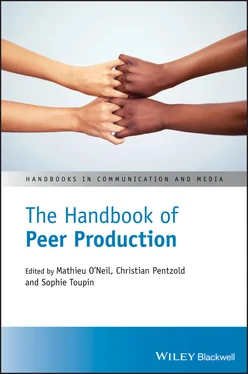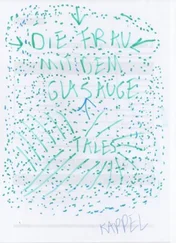Although these five rules are marketed as being central and unchangeable, they nevertheless vary to some extent from one language version to another. For instance, in the German edition, the fifth maxim is missing. Further core institutions like the wikiquette, which has not yet congealed in a Wikipedia code of conduct as in Debian, attended to the conduct among users and therefore to the desirable manners and forms of social interaction. They required Wikipedians to be nice to each other, to be honest, and to abstain from legal threats. Other policies, guidelines, and essays dealt with, for example, the resolution of disputes, the organization of editing, and the handling of vandalism. They rest on regulatory practices that date back to the time of early Usenet applications and mailing lists (Baym, 1996; Sternberg, 2012).
In sum, they form the “Wikipedia policy environment” (Morgan & Zachry, 2010, p. 165), that has evolved in reaction to the editors’ need to handle emerging contingencies. The majority of policies tended to focus on process and legal issues whereas guidelines often dealt with content matters, and essays were mostly dedicated to user behavior. Like in other peer production ventures, Wikipedia’s “genre ecology” (Morgan & Zachry, 2010, p. 165) of policies, guidelines, and essays is mushrooming in character (Butler, Joyce, & Pike, 2008; Halfaker et al., 2013). In January 2008, Morgan and Zachry (2010) sampled 47 policies, 232 guidelines, and 404 essays. In his survey of March 2009, Reagle (2010a) found 686 pages in page categories relevant for organizing collaboration with 104 proper rule pages. Five years later, Jemielniak (2016) collected more than 1,200 regulatory documents in the English‐language edition and counted 150,000 words in the 50 main policies.
The three groups of Wikipedia institutions provide no clear‐cut and exclusive order but rather are a “helter‐skelter hodgepodge” (Kostakis, 2010) with different levels of validation, integrity, irreversibility, and legitimacy. The extensive and somewhat haphazard corpus of provisions, conventions, and personal advice or opinions seeks to stipulate aspects of working on and in Wikipedia (Tkacz, 2016). Some purvey concrete descriptions of procedures and rationales for making decisions, others instead are composed of formulaic mottoes without tangible directives. They are complemented by a repository of software utilities created for aligning the content and patrolling contributions according to the standards in place. A vast number of robots or bots are, for example, maintained in order to handle menial tasks like fixing broken links or correcting typos. In Wikipedia’s “sophisticated technomanagerial system” (Niederer & van Dijck, 2010, p. 1373), these tools, in combination with semi‐autonomous editing interfaces, increasingly support the enforcement of rules, for instance, when they facilitate the detection and reversion of vandalism (Geiger & Ribes, 2010). In this way, technological assistants assume an increasing share of the contributions and also sustain the implementation of institutions. In July 2017, bots made about 20 per cent of all edits (Geiger, 2017). Referring to the technical protocols that steer the activity of bots, Müller‐Birn, Dobusch, and Herbsleb (2013) spoke of an “algorithmic governance” (p. 80) sustaining peer production.
4 How to Create Rules and Norms? Institutional Work in Peer Production
There is no single way of establishing institutions in peer production. Given the participatory and emerging nature of its endeavors, users stress the idea that regulations and normative stances have to reflect established consensus and routines: practice reifies in policy. In effect, institutions should be linked back to changing consensus about the aims and scope of a project, conventional ways to contribute, or shifting values. Rules also ought to respond to urgent issues that require regulation. In this respect, a Wikipedia manual for example declared that “policies and guidelines are typically altered to reflect changing practice on the site or to solve a problem that has arisen” (Ayers, Matthews, & Yates, 2008, p. 369). Rules and social norms codify the status quo of practice and sensemaking in peer production and provide them with an obligatory force.
These purposive actions of creating and implementing institutions can be understood as a kind of “institutional work,” that is, in the words of Lawrence, Suddaby, and Leca (2009), “practical actions through which institutions are created, maintained, and disrupted” (p. 1). In peer production, the construction of rules, the formulation of social norms, and the disposition of more widespread institutional understandings should be an ongoing, inclusive, and open‐ended process. It runs through different stages from informal, local, and ad hoc rulings to more long‐term and holistic determinations (Kriplean et al., 2007). In ideal form, institutions are created in proposals which are then discussed and modulated until a consensus can be reached among the contributors. If commonly accepted, they become codified both in texts as well as in software which then direct their interpretation and enforcement. In this regard, institutions usually are “socially constructed, routine‐reproduced,” as Jepperson (1991, p. 149) held, despite instrumental schemes to install particular regulations or to exact a ruling deemed official and binding. In principle, the formulation and adaptation of institutions is conceived of as an incremental bottom‐up process.
Rules in peer production typically arise from many individual contributions. Their repute stems from the alleged broad inclusion of perspectives, the user acceptance of the process in which the institutions are configured and implemented, and the concrete provisions of what to do in terms of promoting productive cooperation and social interaction. In written form, they are shared and can be inspected and revised if need be. Yet rightly because the process and its outcomes are designed to be open and integrative, there is no linear development from heuristics to negotiated formal rules. Instead, the contributors uphold an enduring debate. The contentious struggles about the adequate form, scope, and application of institutions originates in the fluctuating user base with veterans leaving projects while new participants enter. These shifting populations, in connection with the fluid formation of the projects, propel continuous discussions around the organization of cooperation and the inspection of project products.
In order to compensate for this kind of friction, peer production collectives have proceduralized and decentralized the creation and enforcement of institutions (Beschastnikh, Kriplean, & McDonald, 2008; Jemielniak, 2016). For instance, in Wikipedia, Forte, Larco, and Bruckman (2009) discovered, on the one hand, a formalization of rule‐making and, on the other, tendencies to decentralize their implementation. As the project matured, the formation of governance mechanisms was refined and assigned to institutionalized bodies. Hence, in the early Wikipedia conflicts among users were usually resolved according to fiat with the project founder Jimmy Wales acting as ultimate “benevolent dictator.” Over time, a special arbitration committee assumed many of these competencies. It follows a set course of evidence and deliberation in order to make decisions. These procedures were reproduced in separate projects and sub‐projects of Wikipedia. Therefore, the effort to apply rules was decentralized and spread across a broader set of contributors. Decentralization, therefore, helped to reflect community concerns and to involve a growing editor base in these tasks.
However, the increasing standardization of activities implies the decelerating creation of new policies whereas the interpretation of existing rules rests with senior members, rendering them less open to reversion (Kriplean et al., 2007; Morgan et al., 2012). “Calcification of policy is disproportionately felt by newer editors, who see their policy edits rejected at a higher rate,” hence concluded Halfaker et al. (2013, p. 683). In the English‐language version of Wikipedia, the growth of policies began to slow down in 2006 (Forte et al., 2009). In 2005, 217 new policies were proposed, 12 of which were accepted. In 2011, this number had dwindled to only 16 new proposals while the acceptance rate of 7.5 per cent remained stable (Halfaker et al., 2013). In contrast, institutional innovation has switched to essay format. These less restricted and binding documents responded to an increasing bureaucratization of the overall policy‐making procedures and supported a kind of soft regulatory mechanism. So the number of essays had increased from 69 in 2005 to more than 185 in 2006 and in the following years (Morgan & Zachry, 2010).
Читать дальше


![О Генри - Справочник Гименея [The Handbook of Hymen]](/books/407356/o-genri-spravochnik-gimeneya-the-handbook-of-hymen-thumb.webp)









